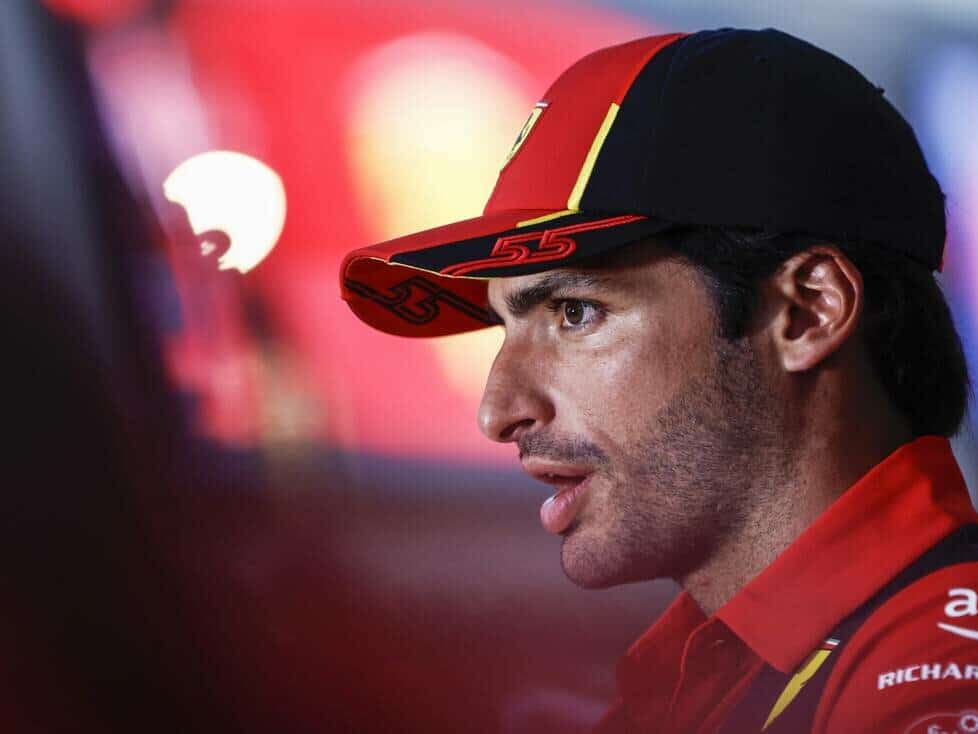Carlos Sainz believes the new tarmac in Qatar could play a role this weekend – Can Ferrari confirm progress on tyre wear?
Ferrari don’t have the best memories of their only Formula 1 race in Qatar to date. In 2021, Carlos Sainz and Charles Leclerc only finished seventh and eighth there – each more than 80 seconds behind race winner Lewis Hamilton.
And even in 2023, there is not a great deal of confidence at the Scuderia ahead of the Qatar Grand Prix. Sainz worries that the track characteristics don’t really suit the SF-23. “I don’t care,” the Singapore winner clarifies at the same time.
“If the car is good enough to be seventh, I want to be P7 on Sunday. If the car is good enough to be third, you want to be P3,” he explains, reminding, “At the same time, we usually do well on sprint weekends.”
The Spaniard therefore hopes that this will “balance out the track characteristics a little bit.” A complicating factor for all riders is also likely to be the heat. It will reach almost 40 degrees during the day in Doha this weekend, and even after sunset it will still be more than 30.
“I think it’s a bit of an extreme case and I hope it doesn’t happen again in the future,” muses Sainz, who stresses that he is well aware that the Grand Prix organisers are always looking for a good date for the races.
Situation “a bit like Turkey 2020”
“But the drivers are suffering from the heat and it’s not going to be a pleasant race,” he stresses, but also clarifies, “I’m not worried because I know it’s very, very hot in Singapore. I drove well in Singapore, so I’m ready for it.”
But even apart from the physical aspect, the conditions in Qatar could be a challenge. Because it’s a sprint weekend, there’s only one practice session in which to work on set-up – and that’s before the sun goes down.
Qualifying, sprint and race, however, take place in the evening in completely different conditions. “It’s not just that. It’s the heat, [and] the new tarmac looks very dirty at the moment. It looks very new, like no one has ever driven on it before,” Sainz said.
The situation is “a bit like Turkey 2020”, he believes. Back then, too, Formula 1 raced on a new asphalt, and the race became a slippery slope as a result – but in very different external conditions to Qatar, as it was very cold and raining then.
“There will be a lot of unknowns,” Sainz muses nonetheless, reminding, “We’ll be running at much higher speeds in qualifying at night [than in FT1].” He stresses, “We will be much faster and we will have to adapt. So there are a lot of challenges. “
Tyre wear: has the problem really been solved?
Specifically for Ferrari, tyres could also play a role again. Although they seemed to have the frequently excessive wear under control most recently in Japan. But Sainz clarifies in this context: “I think it’s too early to say.”
“I’m always very, very cautious about that because the only big change in Japan was the underbody,” says Sainz, who wants to wait for the next few races “to see if that’s really the case. “
“There are six races left and we will see if this good trend continues. I hope so,” he stresses, but makes it clear that he remains sceptical after Japan. He specifies, “Our biggest weakness is tyre life rather than wear.”
“And in a two-stop race [like in Japan] you can influence that better than in a one-stop race where you are at the limit of the tyres for two stints,” he explains. Suzuka, therefore, may not be representative of the rest of the season.
“We have been working a lot on tyre management,” he stresses nonetheless, explaining, “We know that in Formula 1 nothing ever happens out of the blue. It’s always about incremental improvements, and we’ve managed to do that this season. “
Why Sainz was slower than Leclerc in Japan
Sainz and Leclerc finished sixth and fourth respectively in the race in Japan a fortnight ago, with the Spaniard slightly slower than his teammate throughout the weekend. “I don’t think it has anything to do with the upgrade,” Sainz clarifies.
“Charles had a very good weekend in Japan. And as for me, I got a bit lost on Friday because I was trying different things on the car with the set-up,” says Sainz, who explains he has experimented on several Fridays this year.
“It’s an approach I’ve taken this year that maybe in the short term doesn’t pay off in the race […]. But it pays off in the medium to long term,” he is sure. The Spaniard points out that there are practically no more test drives outside the races.
That’s why you have to use the race weekends to try out some things. “I also chose Japan because there are a lot of high-speed corners there. So you can learn a lot, for example for the fast corners in Austin or Qatar,” he reveals.
“That’s why I chose Japan, to test all these things, and I now know what can work here,” he stresses, even though “unfortunately” nothing I tried in Suzuka “worked”. That’s why he was three tenths slower than Leclerc in qualifying.
“But then in the race I was strong again and had more of a base car, so I know what I need to do next weekend,” he stresses. It remains to be seen whether he can actually reap the fruits of his labour in Qatar.





